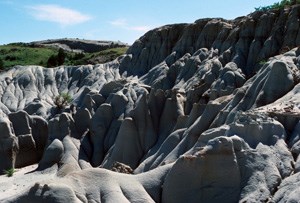
NPS Photo The landscape of the badlands is constantly changing. Soft bentonite clay is easily eroded by wind and water, creating a wrinkled appearance to the ground when observed up close. On a larger scale, water has carved the landscape into a rugged system of buttes and canyons. By their very nature, badlands are constantly changing as the soft sedimentary rock layers erode. Coal veins or seams can be ignited by lightning strikes or wildfires and can burn for many years, baking the surrounding rock and forming red, brick-like porcelanite (locally called scoria or clinker). Porcelanite is more resistant to erosion and is often found on top of many of the buttes and hills. The Little Missouri River is also constantly changing. It meanders within its banks, changing course over the years. It pulses with spring run-off and often barely trickles during the heat of summer while severe summer thunderstorms can cause flash floods and intense scouring by flood waters racing downstream. Learn more about the park's Geology. |
Last updated: April 10, 2015
